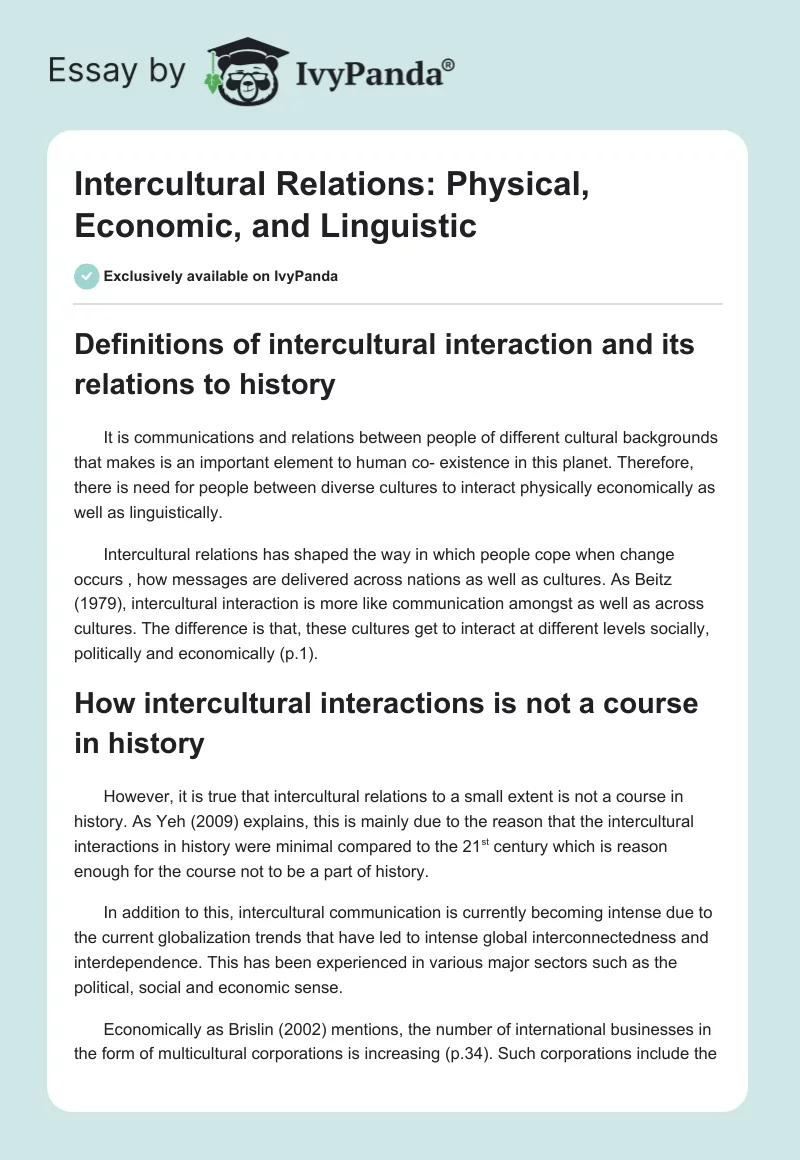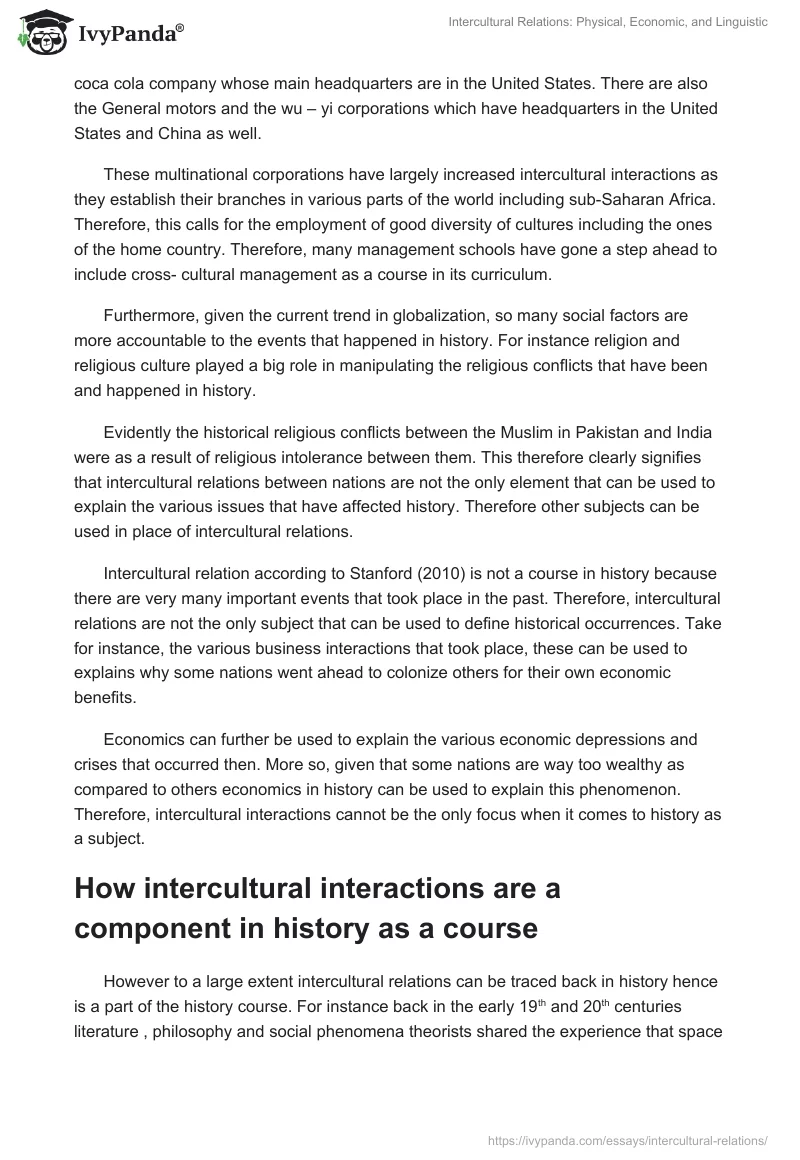Definitions of intercultural interaction and its relations to history
It is communications and relations between people of different cultural backgrounds that makes is an important element to human co- existence in this planet. Therefore, there is need for people between diverse cultures to interact physically economically as well as linguistically.
Intercultural relations has shaped the way in which people cope when change occurs , how messages are delivered across nations as well as cultures. As Beitz (1979), intercultural interaction is more like communication amongst as well as across cultures. The difference is that, these cultures get to interact at different levels socially, politically and economically (p.1).
How intercultural interactions is not a course in history
However, it is true that intercultural relations to a small extent is not a course in history. As Yeh (2009) explains, this is mainly due to the reason that the intercultural interactions in history were minimal compared to the 21st century which is reason enough for the course not to be a part of history.
In addition to this, intercultural communication is currently becoming intense due to the current globalization trends that have led to intense global interconnectedness and interdependence. This has been experienced in various major sectors such as the political, social and economic sense.
Economically as Brislin (2002) mentions, the number of international businesses in the form of multicultural corporations is increasing (p.34). Such corporations include the coca cola company whose main headquarters are in the United States. There are also the General motors and the wu – yi corporations which have headquarters in the United States and China as well.
These multinational corporations have largely increased intercultural interactions as they establish their branches in various parts of the world including sub-Saharan Africa. Therefore, this calls for the employment of good diversity of cultures including the ones of the home country. Therefore, many management schools have gone a step ahead to include cross- cultural management as a course in its curriculum.
Furthermore, given the current trend in globalization, so many social factors are more accountable to the events that happened in history. For instance religion and religious culture played a big role in manipulating the religious conflicts that have been and happened in history.
Evidently the historical religious conflicts between the Muslim in Pakistan and India were as a result of religious intolerance between them. This therefore clearly signifies that intercultural relations between nations are not the only element that can be used to explain the various issues that have affected history. Therefore other subjects can be used in place of intercultural relations.
Intercultural relation according to Stanford (2010) is not a course in history because there are very many important events that took place in the past. Therefore, intercultural relations are not the only subject that can be used to define historical occurrences. Take for instance, the various business interactions that took place, these can be used to explains why some nations went ahead to colonize others for their own economic benefits.
Economics can further be used to explain the various economic depressions and crises that occurred then. More so, given that some nations are way too wealthy as compared to others economics in history can be used to explain this phenomenon. Therefore, intercultural interactions cannot be the only focus when it comes to history as a subject.
How intercultural interactions are a component in history as a course
However to a large extent intercultural relations can be traced back in history hence is a part of the history course. For instance back in the early 19th and 20th centuries literature , philosophy and social phenomena theorists shared the experience that space and distance was rapidly being transformed by the development of high forms of transportation and as well as communication.
These emerged as rail, air transport, telephones and telegraph communication. Evidently, according to the Stanford University (2010) explains that Heinrich Heine a German-Jewish poet acquired the same experience regarding the contraction of space and distance. In his poems, he mentioned that “space is killed by railways…” clearly, an intercultural interaction was a part of history and therefore, many education systems in the world taught It directly or indirectly.
Intercultural interaction as brought out by Beitz (1979), history already existed back in the day. This is has been brought out by the various clashes and wars that existed back in the day where we get to see national cultures meet. For instance during the first and second world wars the then powerful nations had to put their cultural differences aside and form alliances for the sake of victory (p.62).
The Japanese had to put aside their cultural differences and in unity with the Germans went to war against the United States and its allies. More so, the trade of arms amongst various nations especially the USSR and the USA is eminent that intercultural relations were already taking place in history
In another instance, we get to see that trade was already taking place amongst cultures in the earliest of times. This was however done in the form of barter trade especially where the Indian Ocean trade or the long distance trade was concerned. The Arabs who most of the time got their goods from Africa would exchange the goods they have with the Europeans. Therefore this shows that there was already some form of language that had been developed in order to create some form of understanding between the different races.
In addition, Brislin (2002) goes ahead to explain that intercultural interactions is a component of history given the various important event that took place in the political arena in the between the 17th and the 19th century. The cold war for instance that transformed and shaped the contemporary global ideologies (p.68). It is clear that the western culture with the main influence coming from the United States ended up overtaking the Eastern culture predominantly controlled by the Soviet Union.
The western culture was upholds capitalism and more so individualism while on the other hand the eastern culture emphasized on the communism or rather collectivism. This has ever since played a major role in current world politics as well as the education system where students have to learn these cultural differences.
In brief, intercultural interaction is largely a course in history that tends to explain the various events that occurred in history. This especially applies to political aspect in history where there were various wars and conflicts. More so, the economic aspect is also an important component that can be brought through intercultural interaction in history.
On the other hand, intercultural interaction is not a course in history. This is mainly because there were various events that occurred in history that cannot be defined from the intercultural perspective. For instance economics and management nowadays encourage students to study cross-cultural courses offered in their colleges. Intercultural relations are an important element in history as a course.
References
Beitz, C. (1979). Political Theory and International Relations. Princeton: Princeton University Press.
Brislin, R. (2002). Understanding culture’s influence on behavior (2nd ed.). Fortworth: Harcourt Brace publishers.
Stanford University. (2010). Globalization; Stanford Encyclopedia of Philosophy. Web.
Yeh.N.C & Percy. J.(2009). The presentation is part of: F0-1 Globalization and Competition: Economic impacts of Globalization. Web.


